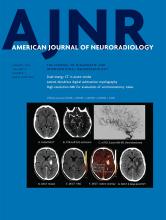Index by author
Langs, G.
- FunctionalYou have accessLesion-Specific Language Network Alterations in Temporal Lobe EpilepsyO. Foesleitner, K.-H. Nenning, L. Bartha-Doering, C. Baumgartner, E. Pataraia, D. Moser, M. Schwarz, V. Schmidbauer, J.A. Hainfellner, T. Czech, C. Dorfer, G. Langs, D. Prayer, S. Bonelli and G. KasprianAmerican Journal of Neuroradiology January 2020, 41 (1) 147-154; DOI: https://doi.org/10.3174/ajnr.A6350
Lavoie, P.
- EDITOR'S CHOICENeurointerventionOpen AccessDoes Increasing Packing Density Using Larger Caliber Coils Improve Angiographic Results of Embolization of Intracranial Aneurysms at 1 Year: A Randomized TrialJ. Raymond, J. Ghostine, B.A. van Adel, J.J.S. Shankar, D. Iancu, A.P. Mitha, P. Kvamme, R.D. Turner, A. Turk, V. Mendes-Pereira, J.S. Carpenter, S. Boo, A. Evans, H.H. Woo, D. Fiorella, A. Alaraj, D. Roy, A. Weill, P. Lavoie, M. Chagnon, T.N. Nguyen, J.L. Rempel and T.E. DarsautAmerican Journal of Neuroradiology January 2020, 41 (1) 29-34; DOI: https://doi.org/10.3174/ajnr.A6362
Does Embolization with Larger Coils Lead to Better Treatment of Aneurysms (DELTA) was an investigator-initiated multicenter prospective, parallel, randomized, controlled clinical trial. Patients had 4- to 12-mm unruptured aneurysms. Treatment allocation to either 15- (experimental group) or 10-caliber coils (control group) was randomized 1:1 using a Web-based platform. The primary efficacy outcome was a major recurrence or a residual aneurysm at follow-up angiography at 12 ± 2 months adjudicated by an independent core lab blinded to the treatment allocation. The trial was stopped after 210 patients were recruited between November 2013 and June 2017 when funding was interrupted. On an intent-to-treat analysis, the primary outcome was reached in 37 patients allocated to 15-caliber coils and 36 patients allocated to 10-caliber coils. Safety and other clinical outcomes were similar. Coiling of aneurysms randomized to 15-caliber coils achieved higher packing densities compared with 10-caliber coils, but this had no impact on the angiographic outcomes at 1 year, which were primarily driven by aneurysm size and initial angiographic results.
Leao, D.J.
- Adult BrainOpen AccessResponse Assessment in Neuro-Oncology Criteria for Gliomas: Practical Approach Using Conventional and Advanced TechniquesD.J. Leao, P.G. Craig, L.F. Godoy, C.C. Leite and B. PoliceniAmerican Journal of Neuroradiology January 2020, 41 (1) 10-20; DOI: https://doi.org/10.3174/ajnr.A6358
Lee, J.H.
- Head and Neck ImagingYou have accessCT and MRI Findings of Glomangiopericytoma in the Head and Neck: Case Series Study and Systematic ReviewC.H. Suh, J.H. Lee, M.K. Lee, S.J. Cho, S.R. Chung, Y.J. Choi and J.H. BaekAmerican Journal of Neuroradiology January 2020, 41 (1) 155-159; DOI: https://doi.org/10.3174/ajnr.A6336
Lee, M.K.
- Head and Neck ImagingYou have accessCT and MRI Findings of Glomangiopericytoma in the Head and Neck: Case Series Study and Systematic ReviewC.H. Suh, J.H. Lee, M.K. Lee, S.J. Cho, S.R. Chung, Y.J. Choi and J.H. BaekAmerican Journal of Neuroradiology January 2020, 41 (1) 155-159; DOI: https://doi.org/10.3174/ajnr.A6336
Lee, S.-T.
- Adult BrainOpen AccessDynamic Contrast-Enhanced MR Imaging of Nonenhancing T2 High-Signal-Intensity Lesions in Baseline and Posttreatment Glioblastoma: Temporal Change and Prognostic ValueI. Hwang, S.H. Choi, C.-K. Park, T.M. Kim, S.-H. Park, J.K. Won, I.H. Kim, S.-T. Lee, R.-E. Yoo, K.M. Kang, T.J. Yun, J.-H. Kim and C.-H. SohnAmerican Journal of Neuroradiology January 2020, 41 (1) 49-56; DOI: https://doi.org/10.3174/ajnr.A6323
Lefevre, P.-H.
- FELLOWS' JOURNAL CLUBNeurointerventionYou have accessFlow-Diversion Treatment for Unruptured Nonsaccular Intracranial Aneurysms of the Posterior and Distal Anterior Circulation: A Meta-AnalysisF. Cagnazzo, P.-H. Lefevre, I. Derraz, C. Dargazanli, G. Gascou, D.T. di Carlo, P. Perrini, R. Ahmed, J.F. Hak, C. Riquelme, A. Bonafe and V. CostalatAmerican Journal of Neuroradiology January 2020, 41 (1) 134-139; DOI: https://doi.org/10.3174/ajnr.A6352
The authors’ aim was to analyze the outcomes after flow diversion among nonsaccular unruptured lesions. Fifteen studies (213 aneurysms) were included in the analysis. The long-term adequate occlusion rate was 85.3%. Treatment-related complications were 17.4%. Overall, 15% were ischemic events. They conclude that unruptured nonsaccular aneurysms located in the posterior and distal anterior circulations can be effectively treated with a flow-diversion strategy. Nevertheless, treatment-related complications are not negligible, with about 15% ischemic events and 8% morbidity. Larger size (>10 mm) significantly increased the risk of procedure-related adverse events among nonsaccular lesions.
Lehman, V.T.
- Spine Imaging and Spine Image-Guided InterventionsOpen AccessLateral Decubitus Digital Subtraction Myelography: Tips, Tricks, and PitfallsD.K. Kim, W. Brinjikji, P.P. Morris, F.E. Diehn, V.T. Lehman, G.B. Liebo, J.M. Morris, J.T. Verdoorn, J.K. Cutsforth-Gregory, R.I. Farb, J.C Benson and C.M. CarrAmerican Journal of Neuroradiology January 2020, 41 (1) 21-28; DOI: https://doi.org/10.3174/ajnr.A6368
Leischner, H.
- NeurointerventionYou have accessEmergency Conversion to General Anesthesia Is a Tolerable Risk in Patients Undergoing Mechanical ThrombectomyF. Flottmann, H. Leischner, G. Broocks, T.D. Faizy, A. Aigner, M. Deb-Chatterji, G. Thomalla, J. Krauel, M. Issleib, J. Fiehler and C. BrekenfeldAmerican Journal of Neuroradiology January 2020, 41 (1) 122-127; DOI: https://doi.org/10.3174/ajnr.A6321
Leite, C.C.
- Adult BrainOpen AccessResponse Assessment in Neuro-Oncology Criteria for Gliomas: Practical Approach Using Conventional and Advanced TechniquesD.J. Leao, P.G. Craig, L.F. Godoy, C.C. Leite and B. PoliceniAmerican Journal of Neuroradiology January 2020, 41 (1) 10-20; DOI: https://doi.org/10.3174/ajnr.A6358








